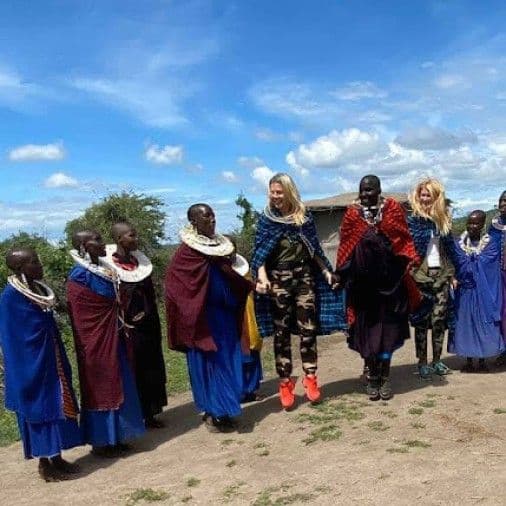People and Culture

THE MAASAI – THE WARRIORS
In the vast plains of Northern Tanzania, you can spot figures donned in vibrant red attire leading herds of cattle. Their movements across the grasslands surrounding the Serengeti and Ngorongoro area are a sight to behold – a graceful and determined stride of true warriors. These incredible people belong to the Maasai tribe, one of Tanzania's most renowned tribes thanks to their proximity to famous National Parks.
Once nomadic across the lands of East Africa, the Maasai have found their home as semi-nomadic herders. Their connection with cows is deeply rooted in their daily lives. Cattle hold immense importance for them, providing essential meat, milk, and even blood for special occasions. In the Maasai culture, cattle represent not only wealth but also a vital source of nourishment. Imagine witnessing a Maasai tribesman proudly tending to a large and healthy herd – it's equivalent to seeing someone speed down a highway in a fancy sports car, a powerful symbol of prosperity.
The Maasai people's way of life is fascinating and awe-inspiring, especially as they continue to preserve their traditions amidst the modern world.
The language spoken by the locals is called "Maa", and the Maasai people are literally known as the "people who speak Maa".
Tradition holds a special place in the everyday lives of the Maasai. They have a fondness for the color red, as seen in their iconic red shuka (traditional cloth) that both men and women elegantly wrap around themselves. Additionally, you will often find Maasai people sporting blue, striped, and checked clothing. To protect their feet from the rough terrain, they wear sandals made from cowhide, while their arms, ears, necks, and heads are adorned with beautiful beaded jewelry.
One of the most captivating sights in Maasai culture is the "Adumu", affectionately referred to as the 'jumping dance'. Adumu involves young men competing in a jumping contest. Traditionally, it is a part of the "Eunoto" ceremony, where young warriors advance in their status within the tribe. Nowadays, when visitors explore Maasai villages, they have the privilege of witnessing a special version of Adumu that is not part of the ceremony. They can even give the athletic jump a try themselves, with guaranteed laughter and enjoyment.
THE DATOGA – CRAFTSMEN, FARMERS, AND FIGHTERS
The Datoga Tribe, living near Lake Eyasi, has a fascinating, yet mysterious history. The men of the tribe are known for their exceptional fighting skills, while the women take care of their homes.
In the past, the Datoga were nomadic, always on the move. However, they have now settled in the Manyara region of Tanzania. Despite their admirable strength, not much is known about their tribe because they have always preferred to keep to themselves.
The Datoga are believed to be indigenous to the Nile Valley, with their roots stretching from southern Sudan to western Ethiopia. As time went on, different groups migrated south and made their homes in Tanzania and Kenya.
The Datoga take great pride in their warrior heritage. They are always striving to defeat any adversaries they encounter, whether they be humans or animals. It is a tradition for young men to showcase their fighting and hunting skills, encouraged by their community.
In today's world, the Datoga may still be somewhat isolated from mainstream Tanzanian society. However, they have adapted to become skilled farmers and craftsmen. Their traditional villages thrive by farming cattle, goats, sheep, and donkeys, as well as raising chickens. It is truly amazing to see how they have evolved throughout history.
THE HADZABE – THE LAST OF THE HUNTER-GATHERERS
The Hadzabe people offer us a fascinating glimpse into the way our ancestors would have lived thousands of years ago. Living in a small area near the beautiful Lake Eyasi, the Hadzabe have been historically nomadic, moving camps as the seasons change and their needs require. It's truly incredible how they continue to live in a similar way to their ancestors!
According to certain oral folklore, the Hadzabe are said to have descended from a tree long ago. Their oral traditions have been passed down for thousands of years, making Hadza one of the oldest languages in the world. The way they speak is so unique, with rhythmic utterances and intriguing clicks. It seems like Hadza is a language that stands on its own, unrelated to any other spoken on our planet.
What sets the Hadzabe apart is their fascinating way of living without calendars or clocks. They don't measure time as we do, which is pretty amazing! And get this - they are reputedly the only people in Tanzania who have never been subjected to taxes. That's quite remarkable, don't you think?
One of the things that truly warms my heart about the Hadzabe is their egalitarian tribe. They believe in shared responsibilities when it comes to raising children, and everyone in the tribe is well cared for. It's wonderful to see such a strong sense of community and fairness among them.
Over the years, pastoralists have started to encroach on the land belonging to the Hadzabe people, which has limited their ability to freely move around. However, there are still many who are determined to preserve the traditional Hadza way of life.
At present, there are a little over 1000 individuals residing in the Lake Eyasi area. In this modernizing world, where external influences seep into tribal communities, only a few continue to live solely as hunter-gatherers. Nowadays, even young children are attending school and university, thanks to the funds generated through interactions with tourists. Many of the Hadzabe who pursue an education return to fight for the historical rights of their people.
The Hadzabe lifestyle is reminiscent of the nomadic ways shared by African communities thousands of years ago. It is a world of liberation, unburdened by modern limitations. Although it is a simpler way of life, it is regrettably fading away.
Along the scenic banks of Lake Eyasi, the Hadzabe harmoniously coexist with nature. They ensure they never exploit or deplete the land beyond its capacity to replenish.
